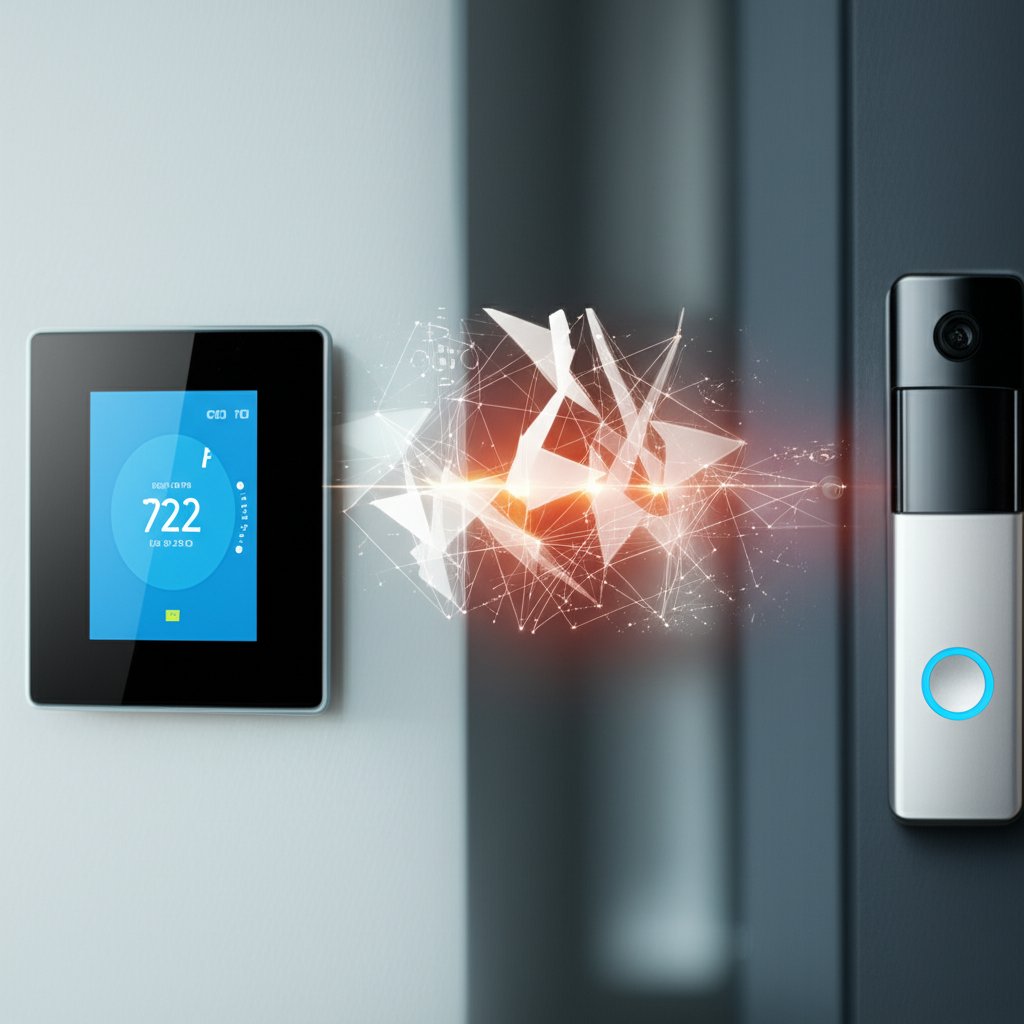Welcome to the era of the smart home! You know, where your lights respond to your voice, your thermostat learns your preferences, and your front door locks itself when you leave. It’s incredibly convenient, isn’t it? But have you ever paused to consider what all this interconnectedness means for your security? While these devices promise to simplify our lives, they can also unwittingly roll out a welcome mat for cybercriminals, turning our sanctuaries into potential digital nightmares. This isn’t about fear-mongering; it’s about empowerment.
As a security professional, I’ve seen firsthand how readily these conveniences can become critical vulnerabilities if left unaddressed. With more smart devices entering our homes and small businesses every day, our digital attack surface is expanding, making us prime targets. This article isn’t just going to point out the problems; we’re going to dive into 5 critical smart home security vulnerabilities that you need to fix now, providing you with practical, easy-to-understand solutions to safeguard your digital life and peace of mind.
The Hidden Risks: Why Smart Homes Attract Cybercriminals
Why are smart homes such tempting targets for hackers? It’s a combination of factors. These devices are constantly connected, often collecting a wealth of personal data – from your daily routines to your conversations. The sheer variety of manufacturers means security standards can vary wildly, and many devices are rushed to market without sufficient security measures in place. This creates numerous entry points for attackers.
The types of attacks can range from annoying to devastating: think data breaches exposing your personal information, device hijacking where hackers take control of your cameras or smart locks, using your devices to launch Distributed Denial of Service (DDoS) attacks, or simply invading your privacy by listening in on your conversations. Smart devices, whether for your home or small business, are becoming integral to our lives, so understanding and mitigating these risks is no longer optional.
How We Selected These 5 Critical Vulnerabilities
When identifying the most pressing smart home security vulnerabilities, we focused on several key criteria:
- Prevalence: How common are these issues in typical smart home setups?
- Ease of Exploitation: How simple is it for an attacker, even one with limited skills, to take advantage of these weaknesses?
- Potential Impact: What’s the worst that could happen if this vulnerability is exploited? (e.g., data theft, physical security compromise, privacy invasion).
- Actionability: Can an everyday user or small business owner implement effective fixes without requiring advanced technical expertise?
Based on these criteria, the following five vulnerabilities represent the most critical and widespread threats to your smart home’s security, demanding your immediate attention.
1. Weak and Default Passwords
This might sound like basic advice, but it’s astonishing how many smart devices and Wi-Fi networks still rely on weak, easily guessable, or even factory-default passwords. Think “admin/password,” “12345,” or the name of your router manufacturer. Hackers absolutely love this, and honestly, can you blame them?
The Problem: Many devices are shipped with universal default login credentials, or users simply don’t bother to create strong, unique passwords during setup. Criminals leverage automated tools to scan for devices with these known defaults or to run brute force attacks, guessing common passwords until they get in. Once they have your Wi-Fi password or access to a single smart device, they can often gain a foothold into your entire home network, potentially spying on you, stealing data, or even recruiting your devices into a botnet to launch further attacks. For small businesses, this could mean unauthorized access to sensitive company data or network resources.
The Fix Now:
- Change Everything: Immediately change all default passwords on your router and every new smart device you set up. If you’re not sure, check the device’s manual or manufacturer’s website.
- Go Strong and Unique: Use a combination of uppercase and lowercase letters, numbers, and symbols. Aim for at least 12-16 characters. Crucially, each device and your Wi-Fi network should have a unique password.
- Embrace a Password Manager: Don’t try to remember them all! A reputable password manager will generate strong, unique passwords for you and store them securely, making this task effortless.
Risk Level: High
Potential Impact:
- Complete network compromise
- Data theft and privacy invasion
- Device hijacking and misuse
2. Outdated Firmware and Software
Just like your smartphone or computer, your smart home devices run on software—often called firmware. Manufacturers regularly release updates for this firmware, and not just to add new features. A significant portion of these updates are critical security patches designed to close newly discovered vulnerabilities that hackers could exploit. Ignoring them is like leaving your front door wide open after the lock manufacturer tells you they’ve found a flaw.
The Problem: Many users simply neglect to install these updates, either because they don’t know they exist, it seems too complicated, or they just don’t get around to it. This leaves devices running on vulnerable software, creating easy entry points for attackers to gain unauthorized access, control your devices, or even install malicious code. Some older devices might even be running on outdated operating systems (like older versions of Linux or Android) that are no longer supported, making them permanent targets unless replaced. For small businesses, an unpatched smart security camera or door lock is an open invitation for a digital breach.
The Fix Now:
- Regularly Check for Updates: Make it a habit to check for and install firmware/software updates for all your smart devices, including your Wi-Fi router, smart cameras, smart hubs, smart speakers, and even smart light bulbs. Most devices have an accompanying app where you can do this.
- Enable Automatic Updates: Wherever available, enable automatic updates. This ensures you’re always running the latest, most secure version of the software without having to think about it.
- Know When to Replace: If a device manufacturer no longer provides security updates (a common issue with older IoT gadgets), it’s time to retire that device, as it will remain a perpetual security risk.
Risk Level: High
Potential Impact:
- Device hijacking and control
- Network intrusion
- Data exfiltration
3. Insecure Wi-Fi Networks
Your Wi-Fi network is the central nervous system of your smart home. Every single smart device relies on it to communicate. If your Wi-Fi is weak or improperly configured, it doesn’t matter how secure your individual devices are; your entire smart home ecosystem is at risk. It’s like having a high-tech alarm system but leaving the main gate unlocked.
The Problem: Weak Wi-Fi passwords, similar to device passwords, are easily guessed. Even worse, some older routers might still be using outdated encryption protocols like WEP, which can be cracked in minutes by basic tools. Furthermore, poorly isolated guest networks or using Universal Plug and Play (UPnP) without understanding its implications can inadvertently expose your internal devices to the internet. An insecure Wi-Fi network grants an attacker easy access to everything connected to it, from your smart fridge to your home office computers.
The Fix Now:
- Strong Wi-Fi Password & WPA2/WPA3: Ensure your Wi-Fi network has a strong, unique password (different from your router’s login password!). Verify that your router is using WPA2 or, even better, WPA3 encryption. Avoid WEP or WPA.
- Change Router Login: Don’t forget to change the default login credentials for your router itself (usually accessed via a web browser). This is separate from your Wi-Fi password.
- Consider a Dedicated IoT Network: If your router supports it, create a separate guest network or a dedicated IoT network (often called a VLAN) for your smart devices. This isolates them from your primary network where your sensitive computers and phones reside, limiting potential damage if an IoT device is compromised.
- Disable UPnP: Universal Plug & Play (UPnP) can simplify device setup but often creates security holes by automatically opening ports on your router. Disable it unless you have a specific, essential need and understand the risks.
Risk Level: High
Potential Impact:
- Full network compromise
- Access to all connected devices
- Interception of network traffic
4. Lack of Multi-Factor Authentication (MFA)
Let’s face it: passwords get stolen. Sometimes it’s a data breach on a service you use, other times it’s a phishing attack. But if a hacker manages to get their hands on one of your smart home account passwords, and you don’t have Multi-Factor Authentication (MFA) enabled, they’ve got the keys to the castle. MFA adds an extra layer of security, typically requiring a second form of verification like a code from your phone.
The Problem: Many smart home apps, hubs, or associated cloud accounts (like those from Amazon, Google, or Apple) offer MFA but users simply don’t enable it. If an attacker acquires your password, without MFA, they can log straight in and gain full control over your devices, access your data, or even impersonate you. This vulnerability isn’t just about the device itself, but the centralized account that controls it. Imagine a hacker logging into your smart home ecosystem app and unlocking your doors, viewing camera feeds, or ordering products.
The Fix Now:
- Enable MFA Everywhere: Make it a non-negotiable step. Enable MFA (also known as two-factor authentication or 2FA) on all smart home apps, device manufacturer accounts, and related big-tech accounts (e.g., Amazon, Google, Apple) wherever it is offered.
- Prioritize Strong Passwords: For any devices or services where MFA isn’t an option, double down on exceptionally strong, unique passwords. A password manager is your best friend here.
- Choose Secure MFA Methods: While SMS codes are better than nothing, authenticator apps (like Google Authenticator, Authy, or Microsoft Authenticator) or hardware security keys offer stronger protection.
Risk Level: Medium to High (depending on password strength)
Potential Impact:
- Account takeover and device control
- Personal data exposure
- Financial fraud
5. Overly Permissive Device Settings & Data Collection
Smart devices are designed to be helpful, but that often means they collect a lot of data about you. Many come with default settings that prioritize convenience over privacy and security, granting broad permissions or enabling features you might not even need. This often includes everything from always-on microphones to cameras streaming unencrypted feeds, or remote access that leaves your home exposed.
The Problem: The rush to market can lead to devices with insufficient privacy controls or confusing settings menus. By default, your smart camera might be uploading video to the cloud without encryption, your smart speaker might be recording more than you think, or your smart lock app might share your location data. Attackers can exploit these overly permissive settings to access sensitive data, spy on your activities, or even bypass local network defenses if devices are directly exposed to the internet. This isn’t just about hackers; it’s about manufacturers and third parties potentially having more insight into your life than you realize.
The Fix Now:
- Review Privacy Settings: Go through the settings of each smart device and its accompanying app with a fine-tooth comb. Adjust privacy settings to be as restrictive as possible, only enabling what you truly need.
- Disable Unused Features: Turn off features like Bluetooth, remote access, or microphones/cameras if you don’t actively use them. Less functionality equals a smaller attack surface.
- Avoid Direct Internet Exposure: Unless absolutely necessary for a specific function, do not expose local network devices directly to the internet via port forwarding or insecure cloud access. Use secure VPNs if remote access is truly required.
- Research Before You Buy: Before purchasing a new smart device, take a few minutes to research its privacy policy and known security track record. Look for companies committed to user privacy and robust security.
Risk Level: Medium to High (privacy & data perspective)
Potential Impact:
- Extensive privacy invasion
- Sensitive data exposure
- Unauthorized monitoring
Beyond the 5: General Best Practices for Smart Home Security
Securing your smart home isn’t a one-time task; it’s an ongoing commitment. To truly defend your digital sanctuary, consider these additional best practices:
- Regularly Audit Your Devices: Periodically review all your connected devices and associated accounts. Do you still use them? Are they still receiving updates? Remove any unused devices from your network.
- Separate Email for IoT: Consider using a dedicated, separate email address specifically for registering your smart home devices and apps. This limits the blast radius if that email is ever compromised.
- Be Cautious on Social Media: Think twice before posting detailed updates about your vacation plans or new smart home gadgets. Such information can signal to potential intruders that your home is empty or has valuable, accessible tech.
- Consider a Smart Home Security Scanner: Some security software offers tools to scan your home network for smart devices and identify potential vulnerabilities. This can provide an extra layer of detection.
- Educate Yourself and Your Family: Security is a shared responsibility. Ensure everyone in your household understands the basics of smart home security, including the importance of strong passwords and privacy settings.
Vulnerability Overview & Action Plan Summary
Here’s a quick reference to the critical vulnerabilities and their immediate fixes:
| Vulnerability | The Problem | Immediate Fix | Key Impact if Unaddressed |
|---|---|---|---|
| Weak & Default Passwords | Easy access for hackers via brute force or known defaults. | Change all defaults, use strong unique passwords, employ a password manager. | Network compromise, data theft. |
| Outdated Firmware & Software | Unpatched security flaws create easy entry points for attackers. | Regularly install updates, enable auto-updates, replace unsupported devices. | Device hijacking, network intrusion. |
| Insecure Wi-Fi Networks | Weak passwords or protocols expose your entire smart home backbone. | Strong WPA2/WPA3 password, change router login, consider IoT-specific network, disable UPnP. | Full network compromise, interception of traffic. |
| Lack of Multi-Factor Authentication (MFA) | Stolen passwords grant full account access without a second barrier. | Enable MFA on all possible accounts, use strong passwords where MFA isn’t available. | Account takeover, device control. |
| Overly Permissive Device Settings & Data Collection | Default settings expose too much data or allow unnecessary access. | Review and adjust privacy settings, disable unused features, research device policies. | Privacy invasion, sensitive data exposure. |
Conclusion
The convenience of a smart home is undeniable, but it comes with a demand for vigilance. Your connected devices are miniature computers, and just like your laptop or phone, they require active security management. Ignoring these common vulnerabilities means you’re leaving the back door open for cybercriminals, potentially compromising your privacy, data, and even your physical security.
But here’s the good news: you don’t need to be a cybersecurity expert to secure your smart home. By understanding these 5 critical vulnerabilities and taking the straightforward, actionable steps we’ve outlined, you can significantly reduce your risks and fortify your digital defenses. Don’t wait for a security incident to force your hand. Start implementing these fixes today for a more secure smart home and reclaim your peace of mind. Your digital sanctuary is worth protecting.









